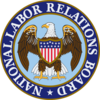NLRB Issues Joint-Employer Final Rule
Office of Public Affairs
202-273-1991
publicinfo@nlrb.gov
www.nlrb.gov
The National Labor Relations Board will issue its final rule tomorrow, February 26, 2020, governing joint-employer status under the National Labor Relations Act. The final rule restores the joint-employer standard that the Board applied for several decades prior to the 2015 decision in Browning-Ferris, but with the greater precision, clarity, and detail that rulemaking allows. As a result, the final rule provides clear guidance in this significant area of the law.
To be a joint employer under the final rule, a business must possess and exercise substantial direct and immediate control over one or more essential terms and conditions of employment of another employer’s employees. The final rule defines key terms, including what are considered “essential terms and conditions of employment,” and what does, and what does not, constitute “direct and immediate control” as to each of these essential employment terms. The final rule also defines what constitutes “substantial” direct and immediate control and makes clear that control exercised on a sporadic, isolated, or de minimis basis is not “substantial.”
Evidence of indirect and/or contractually reserved control over essential employment terms may be a consideration for finding joint-employer status under the final rule, but it cannot give rise to such status without substantial direct and immediate control. Importantly, the final rule also makes clear that the routine elements of an arm’s-length contract cannot turn a contractor into a joint employer.
The joint-employer standard under the NLRA is a matter of consequence because it determines whether a business is an employer of employees directly employed by another employer altogether. If two entities are joint employers, both must bargain with the union that represents the jointly employed employees, both are potentially liable for unfair labor practices committed by the other, and both are subject to union picketing or other economic pressure if there is a labor dispute.
In announcing the final rule, NLRB Chairman John F. Ring stated, “This final rule gives our joint-employer standard the clarity, stability, and predictability that is essential to any successful labor-management relationship and vital to our national economy.” He added, “With the completion of today’s rule, employers will now have certainty in structuring their business relationships, employees will have a better understanding of their employment circumstances, and unions will have clarity regarding with whom they have a collective-bargaining relationship.”
The NLRB issued an NPRM concerning joint-employer status under the NLRA on September 13, 2018. In response to its request for public comments, the Board received and considered nearly 29,000 comments. The final rule will be effective April 27, 2020.
Chairman Ring was joined by Board Members Marvin E. Kaplan and William J. Emanuel in issuing the new joint-employer final rule.
Click here to view the Fact Sheet.
Established in 1935, the National Labor Relations Board is an independent federal agency that protects employees, employers, and unions from unfair labor practices and protects the right of private sector employees to join together, with or without a union, to improve wages, benefits and working conditions. The NLRB conducts hundreds of workplace elections and investigates thousands of unfair labor practice charges each year.
###


